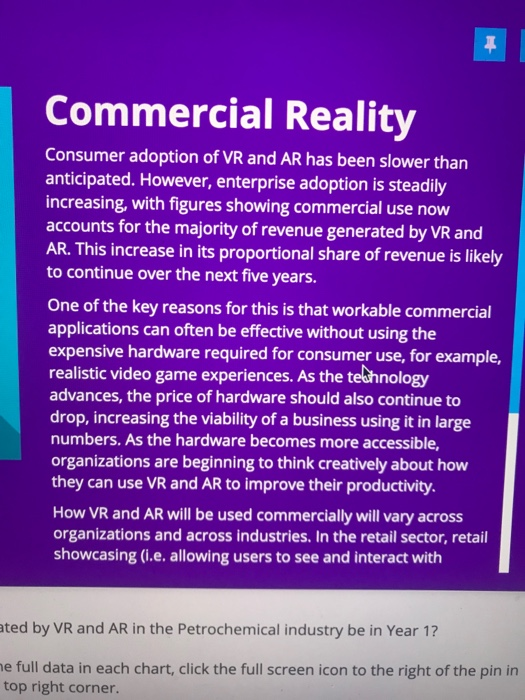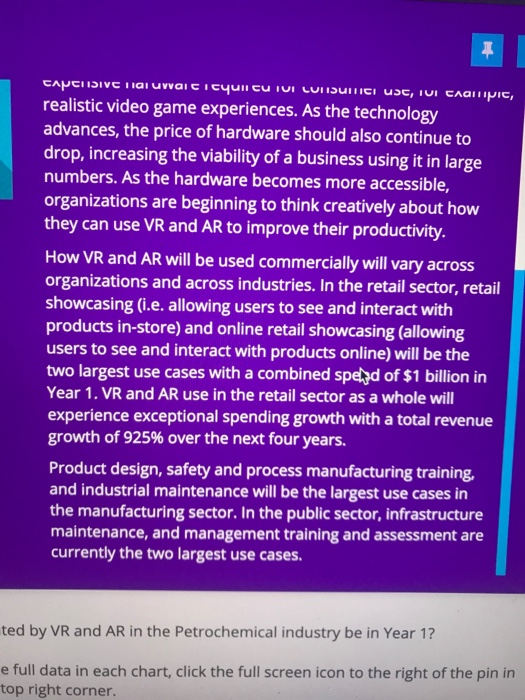Commercial Reality Consumer adoption of VR and AR has been slower than anticipated. However, enterprise adoption is steadily increasing, with figures showing commercial use now accounts for the majority of revenue generated by VR and AR. This increase in its proportional share of revenue is likely to continue over the next five years. One of the key reasons for this is that workable commercial applications can often be effective without using the expensive hardware required for consumer use, for example, realistic video game experiences. As the technology advances, the price of hardware should also continue to drop, increasing the viability of a business using it in large numbers. As the hardware becomes more accessible, organizations are beginning to think creatively about how they can use VR and AR to improve their productivity, How VR and AR will be used commercially will vary across organizations and across industries. In the retail sector, retail showcasing (I.e, allowing users to see and interact with ited by VR and AR in the Petrochemical industry be in Year 1? le full data in each chart, click the full screen icon to the right of the pin in top right corner CAVCISIVE HII UNIC ICYull CU IUI LUIISITICI usc, TUI taalric, realistic video game experiences. As the technology advances, the price of hardware should also continue to drop, increasing the viability of a business using it in large numbers. As the hardware becomes more accessible, organizations are beginning to think creatively about how they can use VR and AR to improve their productivity. How VR and AR will be used commercially will vary across organizations and across industries. In the retail sector, retail showcasing (i.e. allowing users to see and interact with products in-store) and online retail showcasing (allowing users to see and interact with products online) will be the two largest use cases with a combined spe d of $1 billion in Year 1. VR and AR use in the retail sector as a whole will experience exceptional spending growth with a total revenue growth of 925% over the next four years. Product design, safety and process manufacturing training, and industrial maintenance will be the largest use cases in the manufacturing sector. In the public sector, infrastructure maintenance, and management training and assessment are currently the two largest use cases. ted by VR and AR in the Petrochemical industry be in Year 1? e full data in each chart, click the full screen icon to the right of the pin in top right corner. Product design sofer and process manufacturing training and industrial maintenance will be the largest une cones in the maracun sector in the infrastructure Banden Currently the the law Games What will the overall commercial revenue generated by VR and Ain the Petrochemical Industry in e select one answer from the options below. To view the full data in each chart dick the full screen consent of the the top right corner $1.44 Billion O $864 Million O $1.08 Billion O $1.224 Billion $10.8 billion Save & Close Back Te Question Commercial Reality Consumer adoption of VR and AR has been slower than anticipated. However, enterprise adoption is steadily increasing, with figures showing commercial use now accounts for the majority of revenue generated by VR and AR. This increase in its proportional share of revenue is likely to continue over the next five years. One of the key reasons for this is that workable commercial applications can often be effective without using the expensive hardware required for consumer use, for example, realistic video game experiences. As the technology advances, the price of hardware should also continue to drop, increasing the viability of a business using it in large numbers. As the hardware becomes more accessible, organizations are beginning to think creatively about how they can use VR and AR to improve their productivity, How VR and AR will be used commercially will vary across organizations and across industries. In the retail sector, retail showcasing (I.e, allowing users to see and interact with ited by VR and AR in the Petrochemical industry be in Year 1? le full data in each chart, click the full screen icon to the right of the pin in top right corner CAVCISIVE HII UNIC ICYull CU IUI LUIISITICI usc, TUI taalric, realistic video game experiences. As the technology advances, the price of hardware should also continue to drop, increasing the viability of a business using it in large numbers. As the hardware becomes more accessible, organizations are beginning to think creatively about how they can use VR and AR to improve their productivity. How VR and AR will be used commercially will vary across organizations and across industries. In the retail sector, retail showcasing (i.e. allowing users to see and interact with products in-store) and online retail showcasing (allowing users to see and interact with products online) will be the two largest use cases with a combined spe d of $1 billion in Year 1. VR and AR use in the retail sector as a whole will experience exceptional spending growth with a total revenue growth of 925% over the next four years. Product design, safety and process manufacturing training, and industrial maintenance will be the largest use cases in the manufacturing sector. In the public sector, infrastructure maintenance, and management training and assessment are currently the two largest use cases. ted by VR and AR in the Petrochemical industry be in Year 1? e full data in each chart, click the full screen icon to the right of the pin in top right corner. Product design sofer and process manufacturing training and industrial maintenance will be the largest une cones in the maracun sector in the infrastructure Banden Currently the the law Games What will the overall commercial revenue generated by VR and Ain the Petrochemical Industry in e select one answer from the options below. To view the full data in each chart dick the full screen consent of the the top right corner $1.44 Billion O $864 Million O $1.08 Billion O $1.224 Billion $10.8 billion Save & Close Back Te









